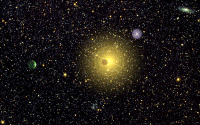Extrasolar planets detected so far
Michel Mayor and Didier Queloz of Geneva Observatory, Switzerland | |
|
|
In 1995, Michel Mayor and Didier Queloz of Geneva Observatory, Switzerland, announced their discovery of the first planet orbiting a star like the Sun. Found by watching the star wobble, the discovery stunned the world because the planet was initially considered the wrong type for the orbit in which it was found. Since then, the number of planets detected by this method has grown rapidly. Currently, the number is approaching 100 and astronomers have realised that whole classes of worlds exist that they had never even imagined.
 Hot Jupiters
Hot Jupiters
Astronomers had initially expected that other solar systems would follow the pattern of our own: small rocky worlds close to the star and gas giants further out. Mayor and Queloz's planet, called 51 Pegasi b, was at least half the mass of Jupiter, the largest planet in our Solar System, but tucked into an orbit eight times smaller than Mercury's, the closest planet to the Sun.
As more detections were made, by both the European team and an American one led by Geoff Marcy, then of San Fransisco State University, it became obvious that 51 Pegasi b was not an isolated freak. There was a class of large planets in tight, circular orbits. Astronomers dubbed these new worlds 'hot Jupiters'. Being in such small orbits, the hot Jupiters whip around their stars in a matter of days.
 Eccentric planets
Eccentric planets
Other data indicated another distinct type of planet. These are also gas giant planets but move in larger, elliptical orbits. In our Solar System, the gas giants all follow more-or-less circular paths.
An eccentric planet may be created when two large planets pass close to one another. During the encounter, one is thrown into the eccentric orbit and remains in the Solar System whilst the other is ejected into interstellar space where it wanders forever. Some astronomers call these planetary rejects, planetars.
 Jupiter analogues
Jupiter analogues
In our Solar System, Jupiter takes 12 years to orbit the Sun, so an observer would have to watch the Sun for a dozen years to see a full cycle and be certain of Jupiter's presence. Astronomers are watching other stars closely for such long-term orbits. As time increases so planets in larger and larger orbits have been found.
The discovery of the first Jupiter analogue was announced by astronomers from the Geneva Observatory in June 2002. The planet, that has a mass equivalent to Jupiter, takes about 7 years to revolve around its sun which is located 553 million km (3.7 AU) from it.
Another bonus from long observations is that, as the data accumulates for stars that are already known to have planets, small discrepancies betray other planets in the system. For example, Upsilon Andromedae is now known to possess a system of three large planets.
A simulated view of the planets around the star Upsilon Andromedae (Image Sylvain Korzennik)
 Why go into space?
Why go into space?
On average, about 15 planets per year are being discovered. Interestingly, hot Jupiters or eccentric planets are found around about 5% of the stars studied. It is still too early to say how many of the other 95% have Jupiter analogues.
The current method of detection will never find Earth-sized worlds because they simply do not pull their parent star enough to be detectable. In order to find other Earths, new techniques of planetary detection are required and these work best from space.


